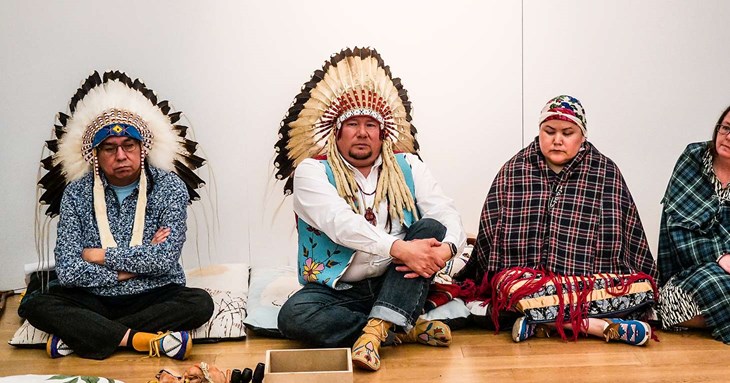Sacred headdress held at RAMM set to return to Canadian homeland
Published: 8 November 2023

Members of the Executive have backed a recommendation to repatriate a sacred headdress to the Blackfoot Siksika people in Canada.
The ceremonial headdress from the Royal Exeter Memorial Museum & Art Gallery collection is traditionally worn by a holy woman of the Holy Buffalo Woman Society known as Motokiks.
It includes traditional components - buffalo horns, feathers from sacred birds and porcupine quills, but was further enhanced with British-made red trade cloth and brass bells. This adornment reflects the original owner's high status.
RAMM’s headdress once belonged to one of these holy women, and with the support of contemporary members of the society it has been able to research its origins.
The Council’s Executive approved a recommendation that legal ownership of the headdress is surrendered and transferred to the Blackfoot Tribal Council of the Siksika Nation.
The report to Executive said: “The debate on repatriation is a fast-moving one, and agreeing to the return will demonstrate that Exeter City Council through the Royal Albert Memorial Museum is prepared to lead sectoral change and to demonstrate trust and respect to international communities.”
Cllr Laura Wright, Deputy Leader and Lead Councillor for Culture, said: “It is so important that this sacred headdress is returned to the Siksika people and I want to thank the team at RAMM for their hard work in helping to facilitate and enable the return to its rightful owners through a lengthy process.
“It is very important that as we learn things and discover things we can readdress and retell history that until now has been presented in a certain way. I know that is happening at RAMM and will continue to happen, and this is a great example of it.”
The headdress was bequeathed to the Museum in 1920 by Edgar Dewdney, a Lieutenant Governor of the Northwest Territories, and had been publicly displayed at RAMM since 1920.
In 2013 a Blackfoot delegation representing the Siksika, Kainai and Blackfeet Nations identified the headdress as a sacred ceremonial headdress. It should not have been displayed and has since been cared for in store.
In May 2022 Siksika Elders visited Exeter in connection with the repatriation of Chief Crowfoot’s regalia and again viewed the headdress. During their visit they stressed the sacred significance of the headdress to the community.
In September 2022, RAMM received a formal letter from the Blackfoot (Siksika) requesting an act of repatriation.
It is likely that representatives of the Siksika Nation will travel to the UK to collect the headdress.
An Equality Impact Assessment on the Executive recommendation said: “Inequalities are embedded in our understanding of history, composed as it is by multiple and changing narratives, based on different experiences; perspectives and reappraisal of events.
“The discovery of new facts or exposure of past injustices and inequality result in disputed or rewritten histories. British Colonial history is one such area. Its reach means that it is a global history intersecting with those of many other nations and communities.
“Its legacy continues to shape life in the UK today. However, we now recognise the oppression and exploitation it caused to other people, including the First Nations of Canada.
“Attempts to assimilate indigenous people into Canadian society erased their identity, rights, and territories and created institutionalised discrimination on the basis of race (ethnicity); religion and belief, all Protected Characteristics under the Equalities Act.”
